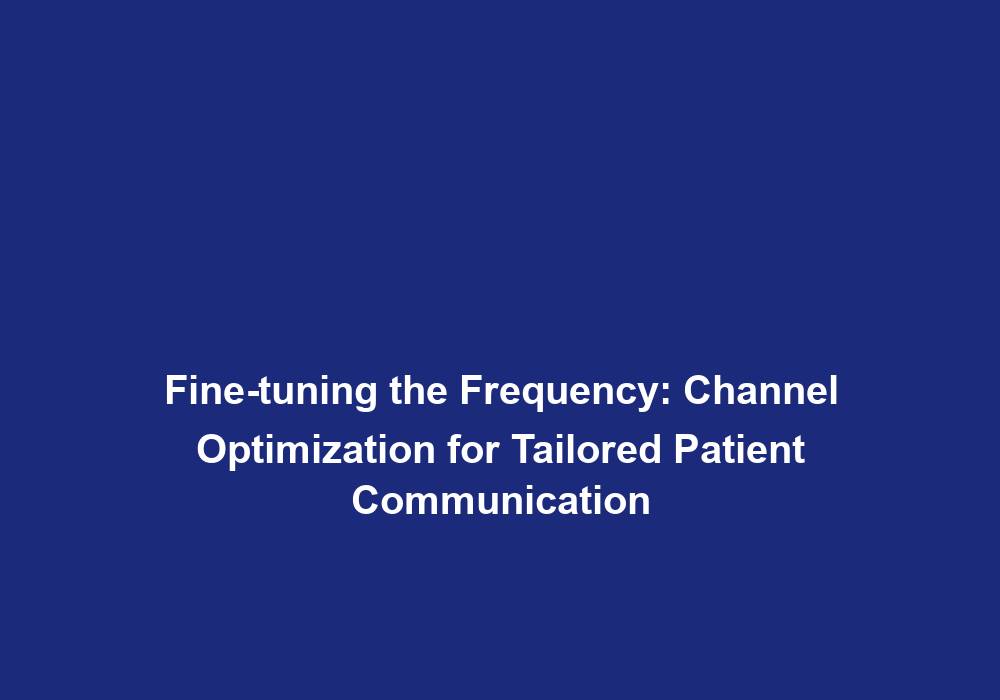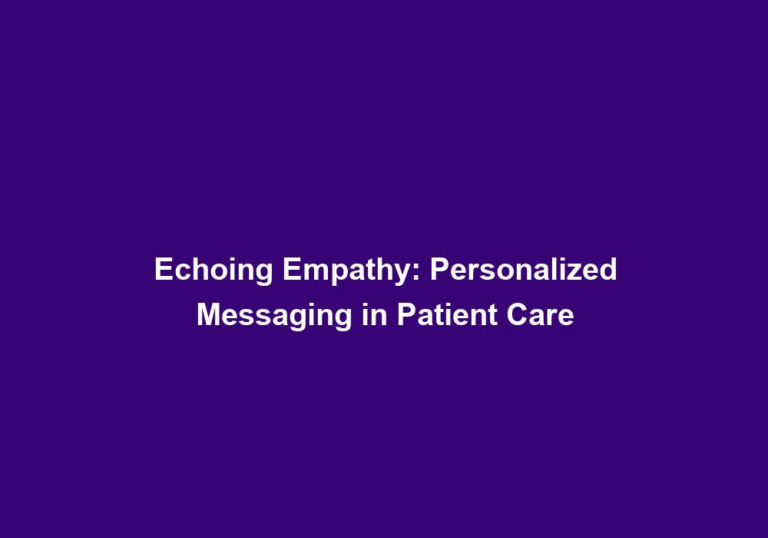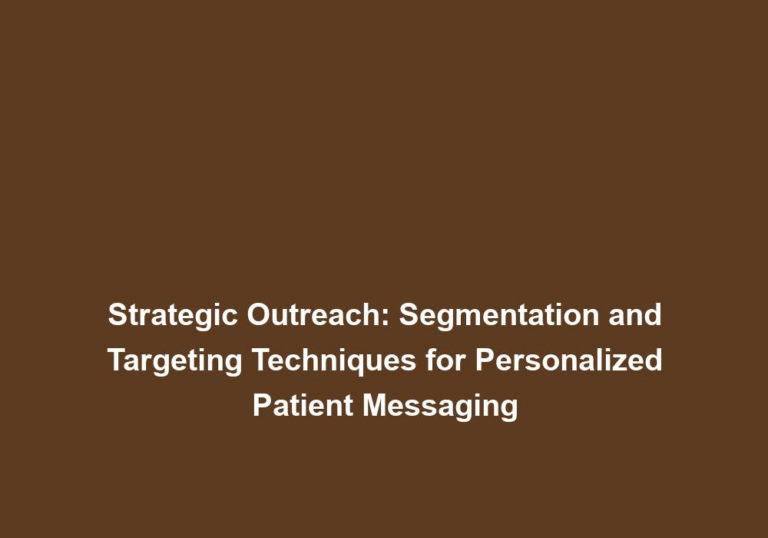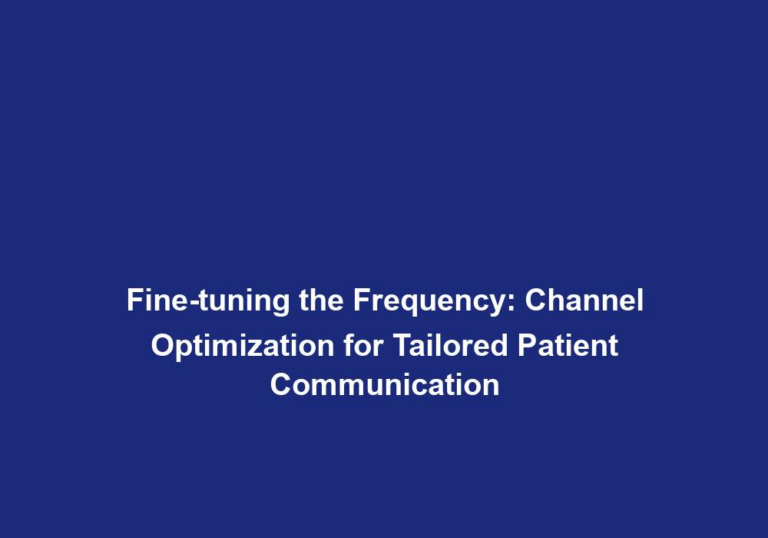Fine-tuning the Frequency: Channel Optimization for Tailored Patient Communication
In today’s digital age, effective communication plays a crucial role in establishing a strong connection between healthcare providers and their patients. With numerous channels available, it is essential to optimize the frequency and delivery of patient communication to ensure personalized and tailored experiences. This article aims to provide insights into channel optimization strategies that can help healthcare organizations fine-tune their patient communication efforts.
The Importance of Tailored Patient Communication
Tailored patient communication involves delivering relevant and personalized information to individual patients based on their specific needs, preferences, and health conditions. By customizing communication, healthcare providers can improve patient engagement, satisfaction, and overall health outcomes.
Tailored communication is vital because it ensures that patients receive the information they need in a format that suits them best. By delivering personalized messages, healthcare providers can address the specific concerns and preferences of each patient, making them feel valued and understood. This level of customization not only enhances patient engagement but also improves the overall patient experience.
Understanding Channel Optimization
Channel optimization refers to the process of selecting the most appropriate communication channels and optimizing their usage to reach patients effectively. It involves understanding patient preferences, analyzing available channels, and strategically utilizing them to deliver tailored messages.
To optimize patient communication channels, it is crucial to understand the various channels available and their advantages and disadvantages. By analyzing each channel’s strengths and weaknesses, healthcare organizations can determine which channels are most effective for different types of communication. For example, while email may be suitable for delivering detailed information or educational resources, text messages may be more suitable for quick reminders or urgent updates.
Additionally, channel optimization requires a deep understanding of patient preferences and behaviors. By gathering data through surveys, feedback, and demographic analysis, healthcare organizations can gain insights into which channels patients prefer and how they prefer to receive information. This information can then be used to tailor communication strategies and ensure that patients receive messages through their preferred channels.
Identifying Patient Preferences
To optimize patient communication channels, healthcare organizations must first understand their patients’ preferences. This can be achieved through various means:
- Surveys and Feedback: Conducting surveys or collecting feedback from patients can provide valuable insights into their preferred communication channels, such as email, text messages, phone calls, or patient portals. This data can help healthcare providers tailor their communication strategies accordingly.
Surveys and feedback allow healthcare organizations to directly ask patients about their communication preferences. By designing targeted surveys and questionnaires, healthcare providers can gather information on which channels patients prefer, how often they want to receive information, and what types of content they find most valuable. This data can then be used to inform communication strategies and ensure that patients receive the information they need through their preferred channels.
- Demographic Analysis: Analyzing patient demographics, including age, gender, and location, can give healthcare organizations an idea of which channels are likely to be more effective for different patient groups. For example, younger patients might prefer digital channels, while older patients might prefer traditional methods like phone calls.
Demographic analysis can provide valuable insights into patient preferences and behaviors. By understanding the characteristics of different patient groups, healthcare organizations can tailor their communication strategies to meet their specific needs. For example, if a significant portion of the patient population is composed of older adults who may not be as comfortable with digital channels, healthcare providers can prioritize phone calls or in-person communication.
- Preference Centers: Implementing preference centers within patient portals or mobile applications allows patients to choose their preferred communication channels. This empowers patients and ensures that they receive information through their preferred channels.
Preference centers are a powerful tool that allows patients to take control of their communication preferences. By providing patients with the option to choose their preferred channels, healthcare organizations can ensure that patients receive information in a way that suits them best. This not only improves patient satisfaction but also increases the likelihood of patients engaging with the information they receive.
Leveraging Various Communication Channels
Once patient preferences are identified, healthcare organizations can optimize their communication by leveraging various channels effectively. Some commonly used channels for patient communication include:
1. Email
Email remains one of the most widely used channels for patient communication. Here are some best practices for optimizing email communication:
- Personalized Subject Lines: Crafting subject lines that are specific and relevant to the content of the email can increase open rates and engagement.
Personalized subject lines grab the attention of patients and make them more likely to open and engage with the email. By tailoring subject lines to the individual patient’s needs or interests, healthcare organizations can increase the effectiveness of their email communication.
- Clear and Concise Content: Providing concise and easy-to-understand information in emails ensures that patients can quickly grasp the message.
In an era of information overload, it is crucial to deliver information in a clear and concise manner. Patients appreciate emails that get straight to the point and provide them with the information they need. By keeping emails concise and easy to understand, healthcare organizations can enhance patient engagement and ensure that patients receive the intended message.
- Call-to-Action Buttons: Including clear call-to-action buttons in emails can direct patients to take specific actions, such as scheduling appointments or accessing online resources.
Call-to-action buttons provide patients with a clear next step, increasing the likelihood of them taking the desired action. Whether it’s scheduling an appointment, accessing a patient portal, or participating in a survey, clear call-to-action buttons make it easy for patients to engage with the email’s content.
2. Text Messages
Text messages have become a popular channel for quick and convenient communication. When utilizing text messages for patient communication, consider the following:
- Permission-based Communication: Ensure patients have given consent to receive text messages and provide an opt-out option if they wish to discontinue receiving such messages.
Respecting patients’ privacy and preferences is crucial when utilizing text messages for communication. Healthcare organizations must obtain patients’ consent before sending text messages and provide an easy way for patients to opt-out if they no longer wish to receive such messages. This ensures that patients feel in control of their communication preferences.
- Short and Informative: Due to character limitations, keep the messages short, concise, and focused on conveying essential information.
Text messages have limited space, so it is essential to keep the messages short and to the point. By focusing on conveying essential information, healthcare organizations can maximize the impact of their text message communication. Patients appreciate receiving concise messages that provide them with the necessary information without overwhelming them.
- Appointment Reminders: Sending appointment reminders via text messages can help reduce no-show rates and improve overall patient adherence.
Text messages are an effective way to send appointment reminders to patients. By sending timely reminders, healthcare organizations can reduce the number of missed appointments and improve patient adherence. Text messages serve as convenient and easily accessible reminders that patients can refer to when needed.
3. Phone Calls
Despite the rise of digital communication, phone calls still play a significant role in patient communication. When utilizing phone calls, consider the following:
- Appointment Scheduling and Reminders: Phone calls can be an effective way to schedule appointments and provide reminders, particularly for patients who may not have access to digital platforms.
While digital channels are becoming more prevalent, not all patients have access to them. Phone calls provide a personal touch and can be an effective way to schedule appointments and provide reminders, especially for patients who may not be comfortable or familiar with digital platforms. By offering phone call options, healthcare organizations ensure that all patients have equal access to important communication.
- Empathy and Active Listening: Train staff to exhibit empathy and active listening when speaking with patients over the phone to create a personal and caring experience.
Phone calls provide an opportunity for healthcare providers to establish a personal connection with patients. By training staff to exhibit empathy and active listening skills during phone conversations, healthcare organizations can create a caring and supportive experience for patients. This personal touch goes a long way in building trust and enhancing patient satisfaction.
- Follow-Up Calls: Conducting follow-up calls after patient visits or procedures can help address any concerns or questions, ensuring patients feel supported and valued.
Follow-up calls are an excellent way to ensure that patients receive the necessary support after a visit or procedure. By reaching out to patients, healthcare organizations can address any concerns or questions they may have, providing reassurance and demonstrating that their well-being is a priority. This level of follow-up care helps build trust and improves patient satisfaction.
4. Patient Portals
Patient portals are secure online platforms that allow patients to access their health records, schedule appointments, and communicate with their healthcare providers. When optimizing patient portals:
- User-Friendly Interface: Ensure the patient portal is easy to navigate and user-friendly to encourage patient engagement.
A user-friendly patient portal is essential to encourage patient engagement. Patients should be able to navigate the portal easily, access the information they need, and perform desired actions without confusion or frustration. By prioritizing a user-friendly interface, healthcare organizations can enhance patient satisfaction and encourage active participation in their own healthcare.
- Secure Messaging: Implement secure messaging functionality within the patient portal to facilitate easy communication between patients and healthcare providers.
Secure messaging is a valuable feature of patient portals as it allows patients to communicate with their healthcare providers conveniently and securely. By enabling secure messaging, healthcare organizations can facilitate easy and direct communication, ensuring that patients can ask questions, seek clarification, or provide updates without the need for in-person visits or phone calls.
- Educational Resources: Provide educational resources, such as articles, videos, or interactive tools, within the patient portal to empower patients to take an active role in managing their health.
Patient portals can serve as a valuable platform for providing educational resources to patients. By offering articles, videos, or interactive tools within the portal, healthcare organizations can empower patients to take an active role in managing their health. These resources can include information about various health conditions, self-care tips, preventive measures, and treatment options. By providing educational resources, healthcare organizations can enhance patient knowledge and encourage proactive health management.
Analyzing and Adapting Communication Strategies
Optimizing patient communication is an ongoing process that requires continuous analysis and adaptation. Healthcare organizations should monitor and evaluate the effectiveness of different communication channels, utilizing data and analytics to make informed decisions. Some key metrics to consider include:
- Open and Click-Through Rates: Analyzing email open and click-through rates can provide insights into the effectiveness of email campaigns.
Monitoring email open and click-through rates can help healthcare organizations assess the success of their email communication. By analyzing these metrics, organizations can identify trends, determine what types of subject lines or content resonate with patients, and make adjustments to improve engagement.
- Text Message Response Rates: Monitoring response rates to text messages can help gauge patient engagement and identify areas for improvement.
Text message response rates provide valuable insights into patient engagement and the effectiveness of text message communication. By monitoring response rates, healthcare organizations can assess whether patients are actively engaging with the messages and identify areas for improvement. This information can inform future communication strategies and ensure that text messages are tailored to meet patient needs.
- Patient Satisfaction Surveys: Conducting regular patient satisfaction surveys can help measure the effectiveness of communication strategies and identify areas for enhancement.
Patient satisfaction surveys are a valuable tool for gathering feedback and measuring the effectiveness of communication strategies. By regularly conducting surveys, healthcare organizations can assess patient satisfaction levels, identify areas for improvement, and make data-driven decisions to enhance patient communication. These surveys can include questions about the preferred communication channels, the clarity of information received, and overall satisfaction with the communication process.
By continuously analyzing and adapting communication strategies, healthcare organizations can refine their patient communication efforts and provide tailored experiences that foster patient engagement and improve health outcomes.
In conclusion, fine-tuning the frequency and optimization of communication channels plays a vital role in tailoring patient communication. By identifying patient preferences, leveraging various communication channels effectively, and continuously analyzing and adapting strategies, healthcare organizations can enhance patient engagement, satisfaction, and overall health outcomes. Remember, effective patient communication is a cornerstone of quality healthcare delivery.







